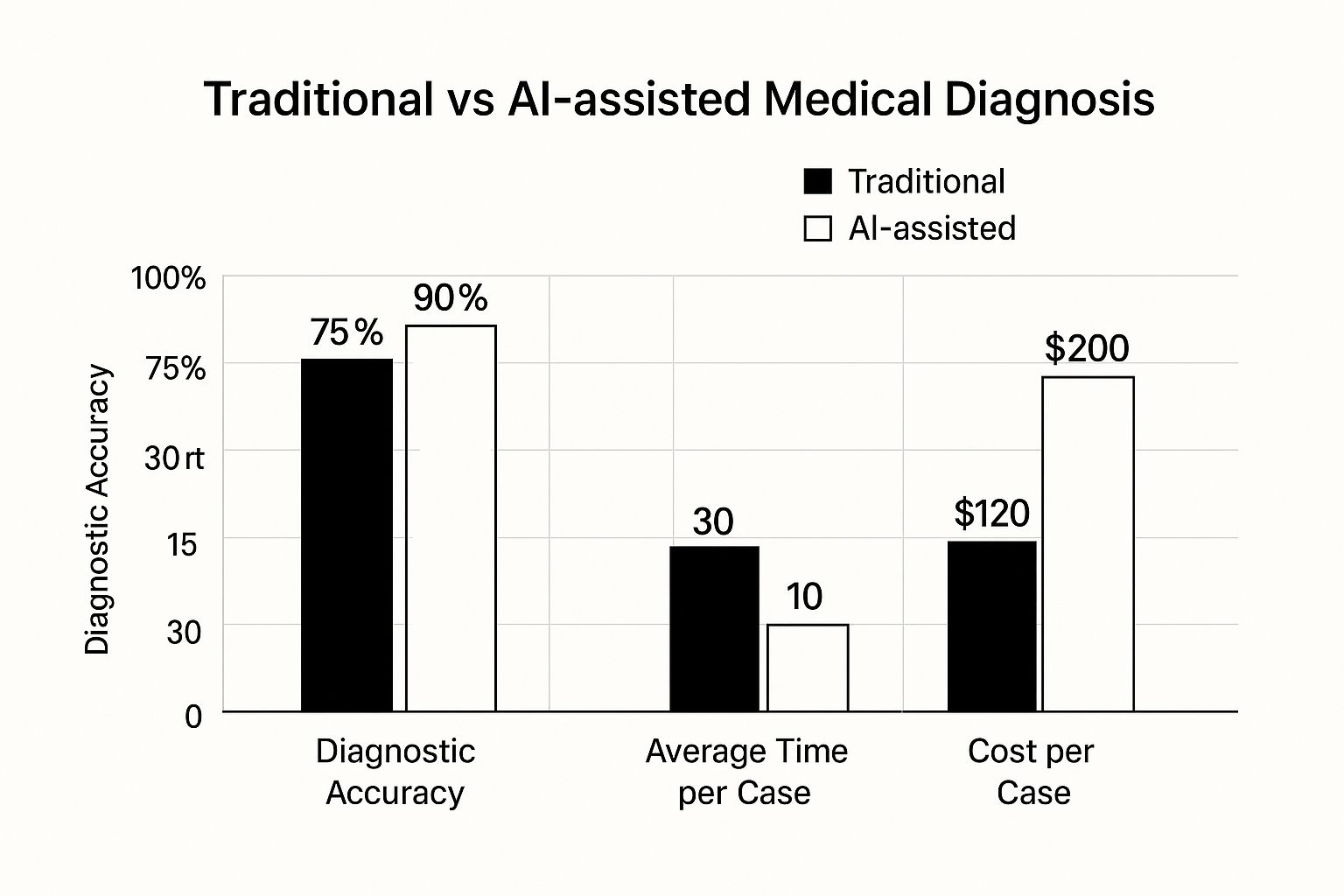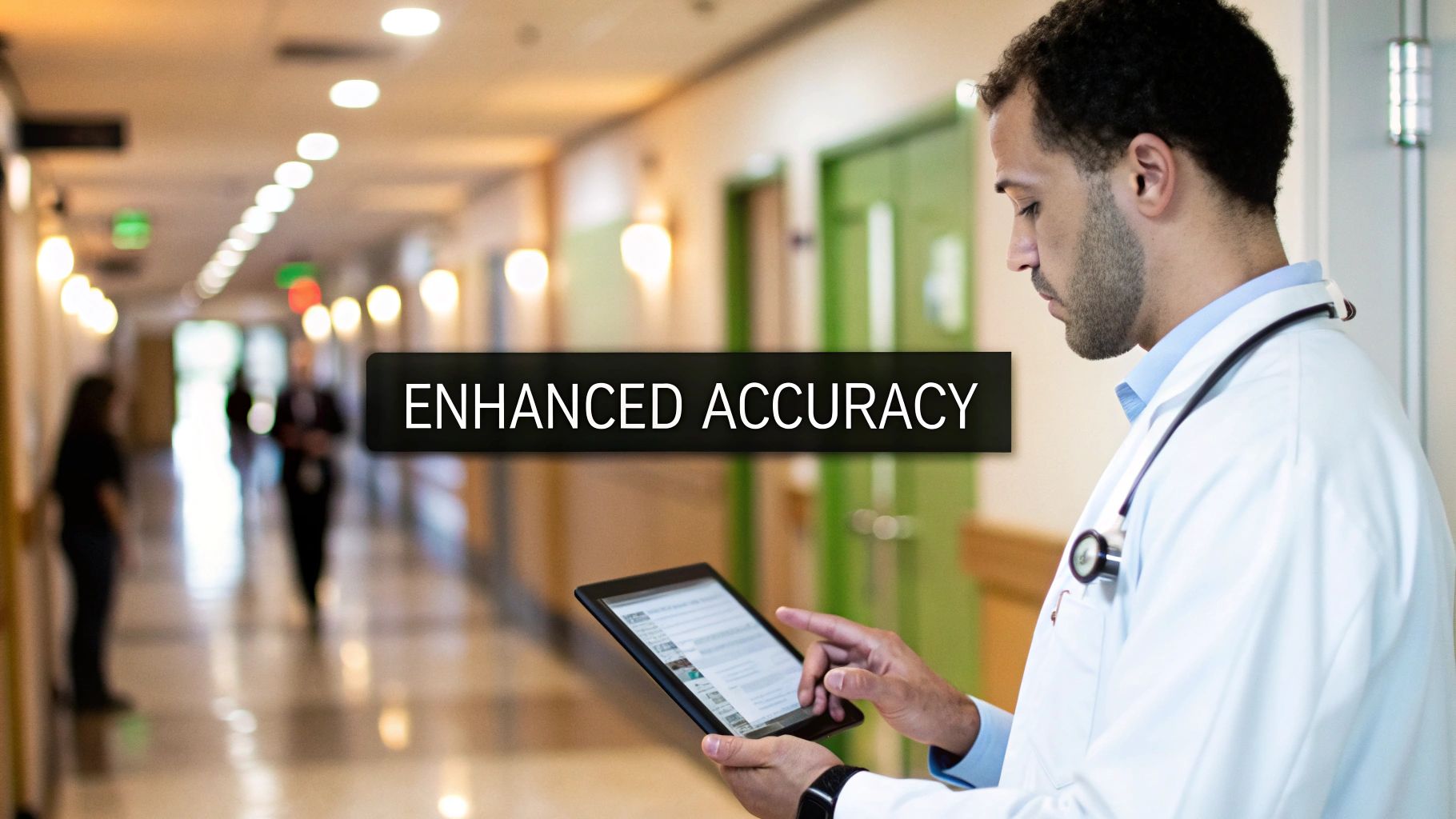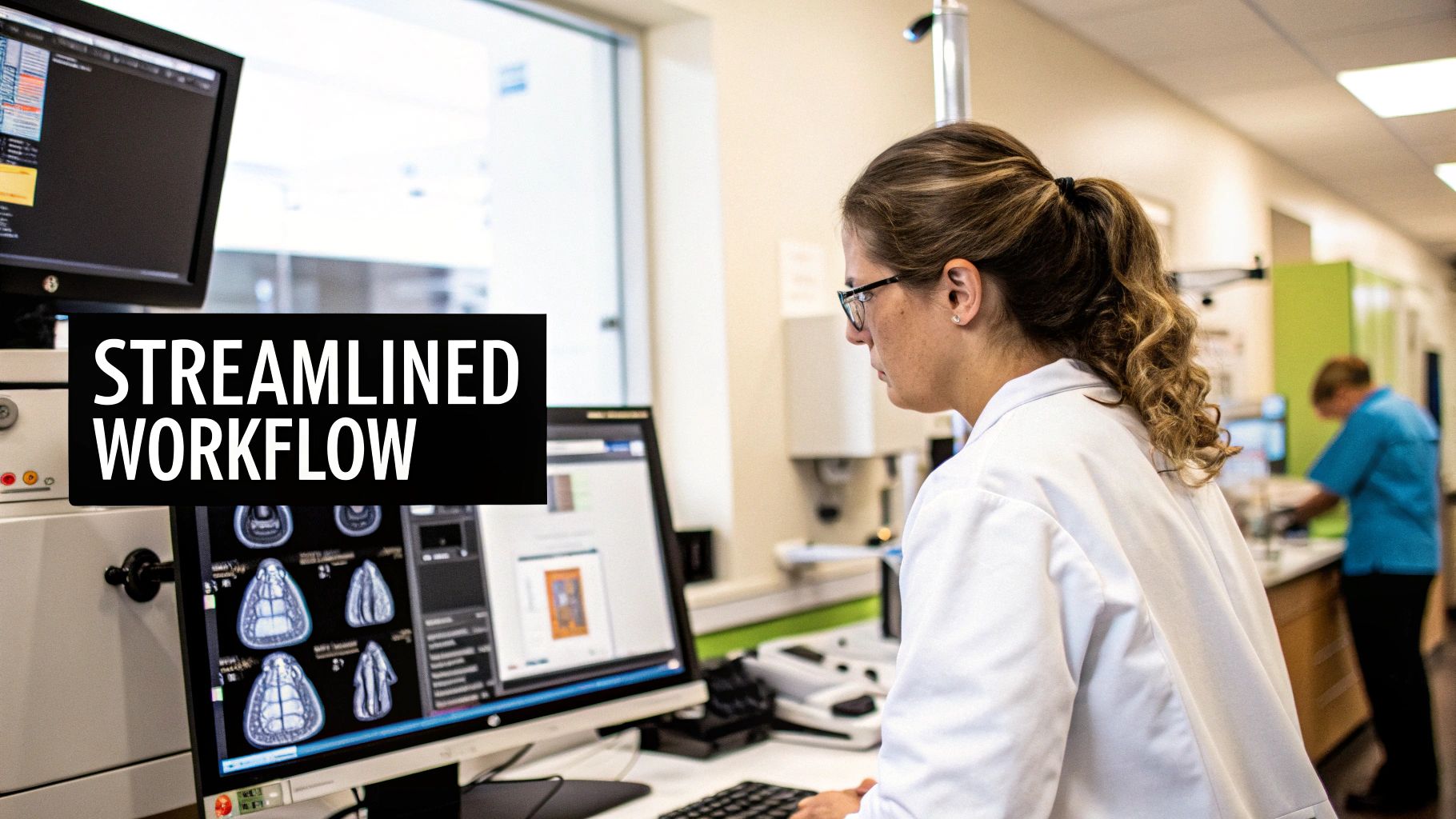Understanding How AI For Medical Diagnosis Works Today
AI for medical diagnosis is changing the way medical professionals approach their work, from diagnosing illnesses and analyzing symptoms to making critical treatment decisions. This shift involves a powerful collaboration between advanced technology and experienced medical professionals, with AI augmenting, not replacing, human expertise. Let's explore how this partnership functions in modern healthcare.
Core Technologies Powering AI Diagnosis
Machine learning algorithms are at the core of AI for medical diagnosis. These algorithms are trained on extensive datasets of medical images and patient records, enabling them to identify patterns, sometimes subtle, that might be missed by the human eye. Imagine a highly trained radiologist who has reviewed millions of X-rays and can instantly spot minute anomalies – machine learning works similarly.
Natural language processing (NLP) tools are another crucial component. NLP can analyze vast quantities of patient records in mere seconds, pulling vital information from doctors' notes, lab results, and other text-based data. This rapid analysis can help pinpoint potential risk factors and speed up the diagnostic process.
Real-World Applications Across Medical Specialties
These AI-powered diagnostic tools are already impacting various medical fields.
- Radiology: AI algorithms analyze medical images (X-rays, CT scans, MRIs) to help radiologists detect tumors, fractures, and other abnormalities more efficiently.
- Cardiology: AI analyzes electrocardiograms (ECGs) to identify irregular heart rhythms, leading to faster diagnoses of heart conditions.
- Emergency Medicine: AI assists in prioritizing patients based on the severity of their condition, ensuring prompt attention for those who need it most.
To illustrate the improvements AI offers, take a look at the infographic below. It compares AI-assisted diagnosis to traditional methods across key metrics.

As the infographic shows, AI contributes to significant gains in accuracy, time efficiency, and cost-effectiveness.
The table below provides further details on AI applications in different medical specialties:
"AI Medical Diagnosis Applications by Medical Specialty"
"Comparison of how AI is being implemented across different medical fields including radiology, pathology, cardiology, and emergency medicine"
| Medical Specialty | AI Applications | Accuracy Improvement | Implementation Level |
|---|---|---|---|
| Radiology | Analyzing X-rays, CT scans, and MRIs for tumors, fractures and other abnormalities | Potentially reducing false negatives by identifying subtle anomalies | Widely adopted, integrated into many hospital systems |
| Pathology | Analyzing tissue samples for cancerous cells and other diseases | Improves speed and accuracy of diagnosis, reducing human error | Growing adoption, particularly for preliminary screenings |
| Cardiology | Analyzing ECGs for irregular heart rhythms and other heart conditions | Enables faster diagnosis and potentially earlier intervention | Increasingly integrated into cardiology practices |
| Emergency Medicine | Prioritizing patients based on severity of conditions, predicting patient deterioration | Improves triage efficiency, potentially saving lives | Emerging applications, showing promise in improving patient flow |
This table highlights how AI is tailored to specific medical fields, leading to varying levels of implementation and accuracy improvements. The wider adoption in radiology reflects the maturity of image-based AI diagnostics. Emerging areas like emergency medicine showcase the potential for future growth and impact.
AI Market Growth and Adoption
The integration of AI in medical diagnostics has seen a significant surge, driven by these demonstrable benefits. The global AI in medical diagnostics market reached $1.71 billion in 2024 and is projected to hit $4.72 billion by 2029, representing a 22.5% CAGR. This impressive growth is fueled by AI’s ability to analyze vast medical datasets, ranging from patient records to complex genetic information, leading to quicker and more accurate diagnoses. Within the European Union, a considerable 42% of healthcare organizations are already leveraging AI for diagnosis, with an additional 19% planning to adopt it in the coming years. Learn more about this growing market here.
The Evolving Role of the Healthcare Professional
It's important to remember that AI is a tool that empowers medical professionals, not a replacement. These technologies handle the often time-consuming task of analyzing large datasets and identifying potential issues, freeing up doctors and nurses to focus on their core strengths: patient interaction, critical thinking, and complex medical decision-making. This collaboration results in a more efficient and accurate diagnostic process, ultimately improving patient care.
Making Complex Medical Data Actually Understandable
Understanding medical information can be challenging. Deciphering lab results or comprehending a diagnosis often leaves patients feeling overwhelmed and confused. However, Artificial Intelligence (AI) is transforming how medical information is presented, making it more accessible and easier to understand. AI is shifting medical communication away from dense technical jargon and toward clear, actionable insights.
Empowering Patients Through Accessible Information
Intelligent explanation tools, powered by AI, are key to this shift toward patient empowerment. These tools break down complex data into digestible summaries. Imagine AI translating your blood work, imaging reports, or even genetic testing results into plain English. This increased accessibility empowers patients to actively participate in their healthcare.
This means patients can ask more informed questions and make well-considered decisions about their treatment. They become true partners in their care, fostering a more collaborative relationship with their physician. Consultations evolve from passive reception to dynamic exchanges of information.

Improving Doctor-Patient Communication
Patient-friendly interfaces, driven by AI, are also vital for improving doctor-patient communication. By providing a common language for discussing complex medical issues, AI bridges the gap between medical expertise and patient understanding. This improved communication fosters trust and increases patient satisfaction. It ensures patients fully grasp their diagnosis, prognosis, and treatment plan, leading to better adherence to medical advice.
One significant trend in AI diagnostics is its ability to transform medical data interpretation. By 2025, AI-powered explanations were projected to improve understanding of lab results by a remarkable 78%. For more detailed statistics, visit Docus AI's blog.
Maintaining Medical Accuracy and Professional Standards
While simplifying data, these AI tools prioritize maintaining medical accuracy and adhering to professional standards. They present information in a way that is both understandable and medically sound. This approach ensures the core medical details remain accurate and complete, even while being patient-friendly. This careful approach also helps avoid potential misinterpretations and ensures the information aligns with established medical guidelines.
A Look at the Technology Behind the Scenes
These patient-friendly interfaces utilize Natural Language Processing (NLP) and Machine Learning (ML). This enables the AI to translate medical terminology into plain language and tailor explanations based on individual patient needs. This personalization ensures the information is relevant and impactful. For instance, AI could explain a diagnosis differently to a teenager than to a senior citizen, accounting for differences in health literacy and cognitive abilities. This personalized approach contributes to a more meaningful and effective experience for each patient. This shift is changing the very nature of healthcare consultations, empowering patients to actively participate in their own care, which can lead to better outcomes and a stronger patient-doctor relationship.
The Economic Reality Behind AI Medical Breakthroughs
The rapid advancement of AI in medical diagnosis represents a significant economic shift in healthcare. This investment boom is changing how we detect and treat diseases, impacting everything from emergency room wait times to personalized therapies.
The Explosive Growth of the AI Diagnostics Market
The AI medical diagnosis market is experiencing remarkable growth. This surge underscores the growing recognition of AI's potential to solve pressing healthcare challenges. This influx of investment leads to tangible improvements, including faster emergency room diagnoses, earlier cancer detection, and more personalized treatments. For further insights into this expanding market, see this report.
The market, valued at $1.62 billion in 2024, is projected to reach $8.08 billion by 2032. This represents a CAGR of 22.31% from 2025 to 2032. The increasing prevalence of infectious and chronic diseases, where AI can play a vital role in early detection and management, fuels this rapid expansion.

Key Drivers of Market Expansion
Several factors contribute to this market growth. The aging global population and the rise in chronic diseases increase the demand for effective diagnostic tools. The need for faster, more accurate diagnoses, particularly in underserved areas with limited specialist access, drives further AI adoption. This demand for improved diagnostics highlights AI's potential to enhance healthcare access and outcomes globally.
Investment Trends Across Medical Specialties
Investment in AI varies across medical fields. Specialties like radiology and oncology attract considerable funding due to AI's potential in image analysis and early cancer detection. This targeted investment reflects the specific needs and opportunities within each medical discipline.
Global Variations in AI Adoption
AI adoption in healthcare differs across countries. Factors such as regulatory frameworks, healthcare infrastructure, and cultural views towards new technologies influence the speed and extent of AI integration. Understanding these variations is essential for developing successful global AI adoption strategies.
The Impact on Healthcare Costs and Accessibility
The long-term economic impact of AI in medical diagnosis is still being evaluated. While initial investments are significant, the potential for cost savings through improved efficiency, reduced errors, and earlier interventions is substantial. AI-powered tools can also enhance healthcare access in remote areas, addressing disparities in care delivery. These potential long-term benefits position AI as a promising tool for tackling global health challenges and improving patient outcomes.
The following table provides a regional breakdown of the AI Medical Diagnosis Market growth. It shows the market size in 2024, projections for 2032, growth rate, and adoption rate by region. This data further illustrates the varying growth and adoption patterns across different geographical areas.
AI Medical Diagnosis Market Growth by Region
| Region | Market Size 2024 | Projected 2032 | Growth Rate | Adoption Rate |
|---|---|---|---|---|
| North America | $750 Million | $3.5 Billion | 20% | High |
| Europe | $500 Million | $2.3 Billion | 18% | Medium |
| Asia Pacific | $250 Million | $1.5 Billion | 25% | High |
| Rest of World | $120 Million | $780 Million | 22% | Medium |
This table highlights the significant growth expected in all regions, with Asia Pacific showing the highest growth rate. North America currently holds the largest market share and demonstrates a high adoption rate. This data underscores the global potential of AI in medical diagnostics and its varying impact across different regions.
Real Stories Of Lives Changed By AI Diagnosis
AI for medical diagnosis is no longer a thing of the future; it's making a real difference in healthcare today. From identifying cancers too small for the human eye to detecting rare diseases quickly, AI is tangibly improving patient outcomes. This section explores real-world examples where AI has transformed diagnoses, offering new hope and a better quality of life.
Early Cancer Detection Through AI-Powered Imaging
AI excels in the crucial area of early cancer detection. One example involves a patient whose lung cancer was discovered at a very early stage thanks to AI-powered analysis of a CT scan. The small nodules, initially overlooked by radiologists, were flagged by the AI system, leading to further investigation and a prompt diagnosis. This early intervention significantly improved the patient's prognosis and treatment options. This highlights how AI is increasing both the accuracy and speed of cancer detection.

AI Detecting Heart Conditions Before Symptoms Appear
AI's impact reaches beyond cancer. AI algorithms analyzing electrocardiograms (ECGs) can detect serious heart conditions weeks before symptoms appear. This early detection enables preventative measures, potentially avoiding a major cardiac event. These cases demonstrate AI's power to predict and prevent serious health issues before they become critical.
Identifying Rare Diseases With Speed and Precision
Diagnosing rare diseases is often challenging, requiring extensive and lengthy testing. AI is changing this by quickly analyzing patient data to identify patterns indicative of rare conditions. For instance, an AI system correctly identified a rare genetic disorder in a child after months of inconclusive tests. This prompt diagnosis allowed doctors to begin appropriate treatment much earlier, significantly improving the child's long-term health. This illustrates the transformative potential of AI in accelerating diagnosis and improving treatment outcomes for complex and unusual diseases.
AI in Emergency Rooms: Prioritizing Patients Effectively
Emergency rooms face the constant challenge of quickly assessing and prioritizing patients based on the urgency of their condition. AI is proving incredibly valuable in this context, helping medical teams make faster, more informed triage decisions. AI algorithms analyze patient data, including vital signs, medical history, and current symptoms, to identify those requiring immediate care. This system enhances efficiency and helps ensure critical patients receive prompt attention.
Enhancing the Skills of Radiologists with AI
Radiologists are using AI as a tool to enhance their expertise. AI-enhanced imaging software helps identify subtle abnormalities in medical images that might otherwise be missed. This combined approach improves diagnostic accuracy and reduces human error. AI handles initial screenings, highlighting potential issues so radiologists can focus their expertise on complex cases and crucial decisions.
AI-Powered Decision Support for Primary Care Doctors
AI is also supporting primary care physicians in making more accurate diagnoses. AI-powered decision support tools analyze patient data and provide evidence-based treatment recommendations. This is particularly helpful in managing chronic conditions and ensuring patients receive the most effective care.
Overcoming Implementation Challenges
Successfully implementing AI in medical diagnosis involves addressing challenges such as staff training, workflow adjustments, and technical integration. Healthcare providers are actively working to integrate AI tools seamlessly into their practices. Sharing experiences and best practices is vital for successful adoption. The potential for improved patient outcomes is driving ongoing efforts to overcome these obstacles. This ongoing adaptation demonstrates the commitment to maximizing AI's benefits in healthcare.
Navigating The Real Challenges Of AI Implementation
Implementing AI for medical diagnosis offers incredible potential, but it also comes with its share of obstacles. Healthcare providers must confront these challenges directly to successfully integrate this powerful technology. This section explores those obstacles, ranging from data privacy and regulatory compliance to the critical aspects of ensuring fairness and building trust.
Protecting Sensitive Patient Data in the Age of AI
A primary concern is the security of patient data. AI systems require access to vast amounts of data, which naturally raises concerns about potential privacy breaches. Healthcare organizations must therefore prioritize robust cybersecurity measures to protect this sensitive information. This includes implementing strong encryption protocols, strict access controls, and regular security audits. Maintaining patient confidentiality is paramount for building trust and ensuring responsible AI adoption.
Navigating the Complex Regulatory Landscape
The regulatory environment surrounding AI in healthcare is constantly evolving. Organizations must carefully navigate a complex web of rules and guidelines to ensure compliance. This includes adhering to data protection regulations like GDPR and HIPAA. Staying abreast of evolving legal frameworks is essential for successful and ethical AI implementation. Maintaining transparency in how AI systems are used and the data they access helps build much-needed patient confidence.
Addressing Algorithm Bias and Ensuring Fairness
AI algorithms are trained on data, and if that data reflects existing biases, the algorithms may unfortunately perpetuate or even amplify those biases. For instance, an algorithm trained primarily on data from one demographic group might be less accurate when applied to a different group. Healthcare organizations must actively work to mitigate bias by using diverse and representative datasets. This includes rigorously evaluating algorithms for potential bias and ensuring they perform fairly across all patient populations. Ensuring fairness and equity in AI-driven diagnosis is crucial for providing equitable care.
Building Patient Trust and Acceptance
Patient trust is absolutely vital for the successful integration of AI in medical diagnosis. Many patients may understandably feel hesitant about relying on "machines" for their healthcare. Open communication about how AI works, its benefits, and its limitations is therefore essential. Emphasizing that AI assists doctors, not replaces them, can help build patient confidence and allay fears. Addressing potential concerns about job displacement and ensuring healthcare professionals feel supported in their evolving roles is also key.
Training and Change Management Within Healthcare Teams
Integrating AI requires substantial training and effective change management. Healthcare professionals need to understand how to use these new tools effectively and how AI fits into their existing workflows. This calls for comprehensive training programs, ongoing support, and clear communication about the changes AI brings to the table. Equipping staff with the necessary skills and knowledge ensures a smooth transition and helps maximize the benefits of AI.
Overcoming Budget Constraints and Technical Integration Issues
Implementing AI can be costly, and many organizations may encounter budget limitations. Finding cost-effective solutions and securing adequate funding are therefore critical for successful adoption. Integrating AI systems with existing hospital infrastructure can also present technical challenges. Addressing compatibility issues and ensuring seamless data flow represent other important hurdles. Practical solutions and strategic planning are vital for overcoming these financial and technical barriers.
Learning from Successful Implementations
Healthcare organizations that have successfully navigated these complexities can offer valuable lessons. Sharing best practices, lessons learned, and practical solutions can help accelerate adoption and minimize risks for others. This collaborative approach benefits the entire healthcare ecosystem and helps ensure that AI is implemented responsibly and effectively for the ultimate goal: improved patient care. Continuous learning and adaptation are essential for maximizing the potential of AI in medical diagnosis.
What's Coming Next In AI Medical Diagnosis
The future of AI in medical diagnosis holds exciting possibilities, pushing the boundaries of what we currently deem achievable. From predicting diseases years before symptoms manifest to personalized diagnostic tools tailored to individual genetic profiles, the potential to reshape healthcare is immense. Let's explore some of these emerging breakthroughs.
Predictive AI: Diagnosing Diseases Before Symptoms Appear
Imagine an AI system capable of predicting Alzheimer's disease decades before the first symptom arises. This is the promise of predictive AI. By analyzing large, complex datasets, these systems aim to identify subtle, pre-symptomatic indicators of future disease. Such early detection paves the way for proactive interventions, potentially delaying or even preventing the onset of debilitating conditions. This predictive power could drastically alter our approach to healthcare, shifting the emphasis from reactive treatment to proactive prevention.
Personalized Diagnostics Based on Your Unique Genetic Profile
AI is also ushering in an era of truly personalized medicine. By analyzing an individual's unique genetic makeup, AI can recommend personalized screening schedules and preventative measures. For example, an individual with a genetic predisposition to certain cancers might benefit from more frequent screenings and targeted advice. This approach optimizes resource allocation, ensuring patients receive the most relevant and effective care tailored to their specific needs.
Quantum Computing: Revolutionizing Medical Imaging
Quantum computing holds significant potential for medical imaging. Its ability to process incredibly complex data could result in substantially more detailed and informative images. This would greatly enhance diagnostic accuracy, particularly for diseases difficult to detect with current imaging technology. Fields like radiology could be revolutionized, enabling doctors to identify subtle abnormalities that might otherwise be missed.
AI-Powered Drug Discovery: Accelerating Medical Advancements
Developing new drugs is a notoriously lengthy and expensive process. AI-powered drug discovery, however, is significantly accelerating this process. AI algorithms can analyze vast molecular libraries to identify potential drug candidates, significantly reducing the time and cost associated with developing new treatments. This accelerated development could bring life-saving medications to market faster, benefiting patients sooner and improving global health outcomes.
AI Health Assistants: Continuous Monitoring for Optimal Health
Consider the benefits of a personalized AI health assistant constantly monitoring your health data from wearable devices and other sources. This assistant could identify deviations from your baseline health and alert you to potential issues early on. This proactive monitoring could facilitate earlier interventions, preventing minor issues from escalating into serious health problems. Integrating AI into daily health management could transform how we approach personal well-being.
The Future of Healthcare: An AI-Driven Approach
These advancements are poised to fundamentally reshape healthcare, from routine checkups to complex procedures. While certain procedures may become automated, the role of healthcare professionals will evolve to focus more on patient interaction, complex decision-making, and the application of AI-generated insights. This shift will require adaptation from both patients and healthcare systems, emphasizing collaboration between humans and AI for optimal health outcomes. Preparing for this AI-driven future is crucial to ensure everyone benefits from these advancements. This includes addressing potential ethical implications and ensuring equitable access to these powerful technologies. By actively addressing these challenges, we can unlock the full potential of AI to build a healthier future for all.
Your Action Plan For AI-Enhanced Healthcare
This rapidly evolving field of AI in medical diagnosis presents exciting opportunities for patients, healthcare professionals, and anyone interested in the future of healthcare. This section offers practical guidance for understanding and utilizing these advancements with a focus on actionable steps you can take today.
For Patients: Navigating AI in Your Healthcare
-
Finding AI-Equipped Providers: Start by researching hospitals and clinics near you that are using AI diagnostic tools. Often, hospital websites and online physician directories will highlight these technological advancements. You can also inquire directly with your current healthcare provider about their current use of AI or any future plans for implementation.
-
Asking the Right Questions: Don't hesitate to discuss AI with your doctor during your appointments. Ask about how AI is being used in your specific case and what benefits it offers. Inquire about the accuracy and limitations of the AI tools employed. A proactive conversation can help ease any concerns and foster informed decisions about your health.
-
Preparing for AI-Assisted Consultations: While AI enhances diagnostic capabilities, it doesn't replace the importance of human interaction. Prepare for your appointments just as you normally would, by compiling relevant medical history and listing your current symptoms. Be open to discussing how AI insights are contributing to your diagnosis and treatment plan.
For Healthcare Professionals: Implementing AI Effectively
-
Evaluating AI Systems: Carefully research and evaluate various AI diagnostic systems. Pay close attention to factors like accuracy, the ease of integration with existing systems, and the specific needs of your practice or hospital. Consider consulting with colleagues who have experience implementing similar technologies.
-
Building Staff Expertise: Invest in comprehensive training programs to empower your team. Equip healthcare professionals with the skills and knowledge they need to effectively utilize these new tools. Ongoing support and clear communication are essential for smooth integration.
-
Successful Implementation Strategies: Develop a phased approach to implementing AI. Begin with pilot projects in specific areas before expanding to wider adoption. Regularly evaluate the results and make any necessary adjustments. Be sure to address potential workflow changes and ensure your staff feels supported throughout the implementation process.
Staying Informed About the Future of AI Diagnosis
-
Follow Reputable Sources: Keep abreast of developments in AI diagnostics by following reputable medical journals, healthcare organizations, and reliable technology news sources. Prioritize sources that offer evidence-based information and avoid hype or speculation.
-
Engage in Discussions: Join online forums and discussions centered around AI in healthcare. Engaging with fellow patients, professionals, and experts can offer valuable insights and perspectives on the evolving role of AI in medicine.
-
Realistic Expectations: While AI holds immense potential, it's crucial to maintain realistic expectations. AI serves as a powerful tool, but it's not a replacement for human judgment and expertise. The future of healthcare relies on a collaborative approach, where skilled healthcare professionals and AI work together synergistically.
PYCAD, a leader in AI-driven medical imaging, offers innovative solutions for optimizing medical devices and improving diagnostic accuracy. Learn how PYCAD can enhance your healthcare technology at pycad.co.
